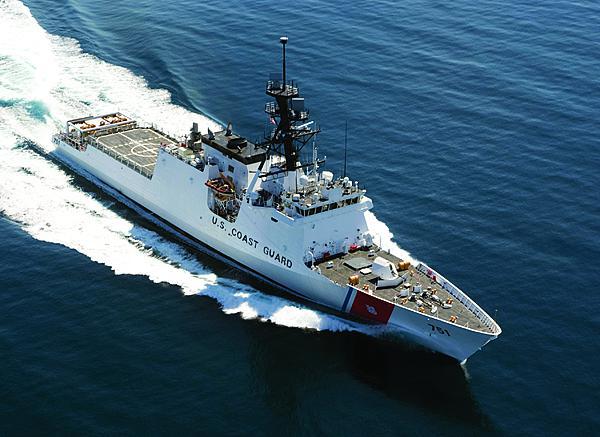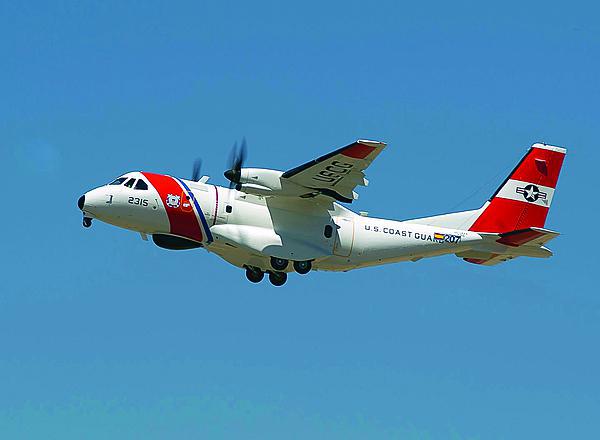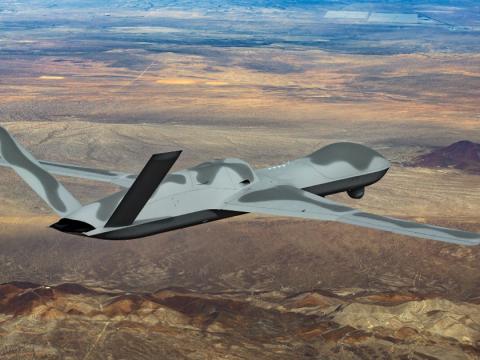Seeking Smoother Interoperability Waters
When the U.S. Coast Guard fields its newest cutter next year, the ship will be equipped with an information technology package that offers common tools and capabilities among the cutter and aviation fleets. The technology suite will improve interoperability across the service and with other agencies, and it enhances situational awareness while providing flexibility for future upgrades.
The Coast Guard’s aviation platforms already have been equipped with the second generation, or Segment 2 Command and Control System, of the technology baseline package developed under the Command, Control, Communications, Computers, Intelligence, Surveillance and Reconnaissance (C4ISR) project. The project is a multiyear effort to design, develop and integrate the equipment on the Coast Guard’s newest assets, including the national security cutter (NSC), long-range surveillance aircraft and the medium-range surveillance aircraft.
The technology suite was installed on the USCGC Waesche NSC in 2013 for technology demonstration purposes. Over time the equipment will be integrated onto all existing NSCs. The project acquires and integrates electronic sensors, networking, data processing and information-sharing equipment, which help Coast Guard operators develop effective situational awareness and interoperate with partner agencies. As the service transitions from obsolete command and control networks to a new standard, called Seawatch, this effort will help to link the Coast Guard’s older assets with its newest. “The key component of the C4ISR project is to advance the Coast Guard’s capability to execute our missions. It ensures we have a set of common tools, common capabilities and a common systems approach across the aviation community and the afloat community, as well as the shore-based community, so that we are interoperable,” explains Capt. John Wood, USCG, who manages the C4ISR program, under which the project falls.
The C4ISR project also improves data sharing with the partner agencies through the use of the joint version of the Global Command and Control System (GCCS). “We built upon the core GCCS capability, not only for our afloat community but also for the aviation community. That allows us more interoperability with the Department of Defense and the Department of Homeland Security,” Capt. Wood states. “It also allows us to integrate both internal sensors and external information into the common operational picture ashore and afloat and in the air. The concept, of course, for GCCS was a common picture for all three areas.”
The Coast Guard’s Segment 2 Command and Control System also adopts the Aegis baseline software 9, including a tactical data link, which further improves data sharing capabilities with the Defense Department. The Aegis software was originally designed as part of the modernization effort for the Navy’s Aegis weapon system. It uses an upgradable, commercial off-the-shelf infrastructure with fiber-optic connectivity. Aegis Baseline 9 and its associated new hardware will facilitate faster system upgrades using readily available commercial hardware and software of proven reliability, according to Navy documentation.
For the Coast Guard, Segment 2 integrates data from air and surface search radars, electro-optical and infrared sensors, friend or foe identification systems and electronic warfare technology. It also has the capability to transmit the correlated track via Link 11, explains Capt. John Healy, USCG, C4ISR project manager. “For the first time, we’re able to transmit and receive real-time link data with the Defense Department.”
The C4ISR project evolved from the much-troubled Integrated Deepwater System Program, commonly referred to as Deepwater. The program awarded a contract in 2002 to a Northrop Grumman-Lockheed Martin consortium to replace aging aircraft, ships and C4ISR technology.
The initial approach was ultimately abandoned. The Coast Guard took over the systems integration role, and the massive program was separated into smaller pieces, with the C4ISR technology and the Fast Response Cutter being procured separately from other platforms. “We’re still executing a lot of the things from Deepwater, but we decided we wanted to make it more competitive. That was kind of the demise of Deepwater,” Capt. Wood recalls.
The Coast Guard’s C4ISR acquisition strategy features a segmented approach, according to a service fact sheet. Each subsequent segment builds upon the previous to avoid technology obsolescence and bring new capability to the fleet at a faster rate. In the process, the project is helping the Coast Guard to establish a new C4ISR capabilities baseline while laying the foundation for greater interoperability. This paradigm will help the Coast Guard to minimize life-cycle costs and keep pace with technology obsolescence by acquiring state-of-the-market, plug-and-play C4ISR tools and capabilities.
The C4ISR project still is scheduled for completion in 2026, the original completion date for the Deepwater program. The project’s milestones, however, are determined by the schedules for the major platforms, Capt. Wood points out.
That long, multiyear procurement of platforms creates some challenges for a technology project in which advances come at a rapid pace. The disconnect between rapidly advancing C4ISR technologies and the relative snail’s pace of ship building makes it difficult to ensure configuration management and cost controls while racing to develop the most current C4ISR capabilities, Capt. Wood states. Operating systems, for example, expire and transition fairly rapidly. “One of the challenges has been the obsolescence that transpired of the whole C4ISR baseline during the fleet production. We’ve gone through the initial baseline, and we’re already on the second generation during the construction of the national security cutters,” Capt. Wood adds. “The tough position we’re in is that as we deliver cutters over a long stretch of 15 years, we can literally go through three cycles of technology. We’re constantly in a tail chase to ensure the information assurance and security of our systems from the first one all the way to the last one.”
And as the service equips platforms being manufactured and fielded, they cannot lose focus on those already in operation. “We continually have to be looking in the rear view mirror to allocate budget to the previously delivered asset as we’re in production. We cannot forget the assets that are currently afloat or in the air,” Capt. Wood declares.
Capt. Healy says commonality is the solution to the problem. “You cope by trying to provide a common set of software across the fleet so that not only does it reduce cost, but it’s also a system that the operator is familiar with as he transfers from one type of vessel to another type of vessel.” He adds that using common software reduces the number of products to be managed and that the hardware will be robust enough to permit the quick evolution of software. “By having common software that you can manage once, that’s one way to cope with the ever-changing technology because you reduce the number of items you have to manage. Ideally, your hardware is robust enough to handle the change in software so that the software can evolve very quickly,” Capt. Healy says.
Capt. Wood agrees. “We’ve tried to create a hardware baseline that is compatible with several iterations of software. What that means is that we’re always trying to refresh the software at a faster rate and trying to hold the hardware solid,” he reports.
Additionally, the project is challenged by the relative lack of government research and development funding. “The government is looking at the private sector for internal research and development toward the next advancement. A lot of times the private sector wants seed money from the government agencies, and that is becoming more rare and difficult to justify and appropriate. A lot of the seed money for advanced technologies has to be invested by the private entity,” Capt. Wood concludes.





Comments